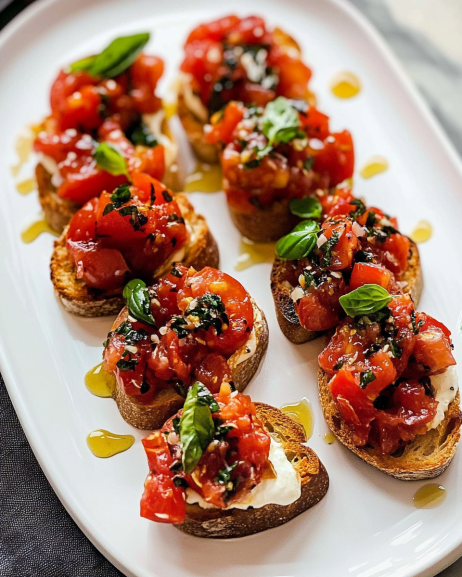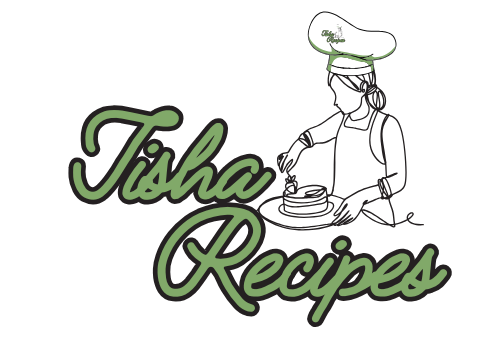
Bruschetta with tomato and basil is a classic Italian appetizer that has earned its place as a staple in global cuisine. Its simplicity and fresh flavors make it a popular choice for gatherings, casual dinners, or as a prelude to a grand meal. At its core, bruschetta is a combination of crusty, toasted bread topped with a mixture of ripe tomatoes, fresh basil, garlic, and high-quality olive oil. This dish perfectly embodies the Mediterranean philosophy of using fresh, high-quality ingredients to create extraordinary flavors.
Overview of Bruschetta
The word “bruschetta” comes from the Italian verb “bruscare,” which means “to toast” or “to roast over coals.” Traditionally, bruschetta was a humble dish used by farmers to salvage day-old bread by toasting it and topping it with simple ingredients like olive oil, garlic, and salt. Over time, this basic preparation evolved to include a variety of toppings, with the tomato and basil version becoming one of the most beloved iterations. Today, bruschetta is not only a celebrated appetizer but also a symbol of Italian culinary heritage.
Brief History and Cultural Significance
Bruschetta’s origins can be traced back to Ancient Rome, where olive growers would toast slices of bread to sample freshly pressed olive oil. This practice laid the foundation for what would become bruschetta as we know it. In Italy, bruschetta remains a versatile dish with regional variations. In Tuscany, it is called “fettunta” and is typically served with just olive oil and garlic. In Southern Italy, tomatoes, basil, and oregano are common toppings, showcasing the region’s abundant produce. The dish’s simplicity highlights the importance of high-quality, seasonal ingredients—a hallmark of Italian cuisine.
Beyond its culinary roots, bruschetta has cultural significance as a dish that brings people together. It is often served at family gatherings, festivals, and celebrations, symbolizing warmth, hospitality, and the joy of sharing food.
Preparation Phase & Tools to Use
Preparation Tips for Success
- Choose Fresh Ingredients: The success of bruschetta depends on the quality of its components. Opt for ripe, juicy tomatoes, fragrant fresh basil, and high-quality olive oil for the best results.
- Use the Right Bread: A crusty baguette or rustic Italian bread works best. The bread should be sturdy enough to hold the toppings without becoming soggy.
- Balance the Garlic: Garlic adds depth to the dish but can easily overpower the other flavors. Use it sparingly or rub it directly onto the toasted bread for a subtle touch.
- Avoid Overloading: Keep the topping-to-bread ratio balanced to prevent the bruschetta from falling apart when picked up.
- Let the Flavors Marinate: Allow the tomato and basil mixture to sit for 10–15 minutes before serving to enhance its flavor.
Essential Tools and Their Importance
- Cutting Board: Provides a clean, sturdy surface for chopping tomatoes, basil, and garlic.
- Sharp Knife: Ensures precise cuts for the tomatoes and basil without bruising them.
- Mixing Bowl: Allows for easy preparation and mixing of the tomato topping.
- Pastry Brush: Used to apply olive oil evenly to the bread slices before toasting.
- Grill or Oven: Toasts the bread slices to perfection, adding a smoky flavor if using a grill.
- Serving Platter: Provides an elegant presentation for the assembled bruschetta.
Ingredients List (with Measurements)
- Tomatoes: 4 large, ripe, and juicy
- Fresh Basil Leaves: 1/4 cup, finely chopped
- Garlic Cloves: 2, minced
- Extra-Virgin Olive Oil: 1/4 cup, plus more for brushing
- Rustic Italian Bread or Baguette: 1 loaf, sliced into 1/2-inch thick pieces
- Salt: To taste
- Freshly Ground Black Pepper: To taste
- Optional Garnish: Balsamic vinegar or glaze for drizzling
Step-by-Step Instructions
- Prepare the Tomato Mixture
- Dice the tomatoes into small, even pieces and place them in a mixing bowl.
- Add the chopped basil and minced garlic to the bowl.
- Drizzle the mixture with extra-virgin olive oil, and season with salt and freshly ground black pepper to taste.
- Stir gently to combine, ensuring all the ingredients are evenly coated. Cover the bowl and let the mixture sit for at least 15 minutes to allow the flavors to meld.
- Prepare the Bread
- Slice the bread into 1/2-inch thick pieces. If using a baguette, cut diagonally for larger slices.
- Brush each slice with olive oil on one side to prevent it from drying out during toasting.
- Toast the Bread
- Using an Oven: Preheat the oven to 450°F (230°C). Arrange the bread slices on a baking sheet and toast for 5–7 minutes, or until golden brown.
- Using a Grill: Place the bread slices directly on a preheated grill and toast for 1–2 minutes on each side until grill marks appear.
- Add the Garlic
- For a more pronounced garlic flavor, rub a peeled garlic clove directly onto the surface of the toasted bread. The residual heat will release the garlic’s aroma and oils, infusing the bread with flavor.
- Assemble the Bruschetta
- Spoon the tomato mixture onto the toasted side of each bread slice, ensuring an even distribution of tomatoes, basil, and olive oil. Avoid overloading to maintain balance and prevent spillage.
- Garnish and Serve
- For added flavor, drizzle balsamic vinegar or glaze over the bruschetta.
- Arrange the bruschetta on a serving platter and serve immediately while the bread is still warm.
Additional Notes
- Tomato Varieties: Use Roma or heirloom tomatoes for their firm texture and sweet flavor. Cherry tomatoes are also an excellent choice for a burst of sweetness.
- Cheese Option: Add a sprinkle of freshly grated Parmesan or crumbled feta for an extra layer of flavor.
- Make-Ahead Tip: Prepare the tomato mixture in advance and store it in the refrigerator for up to 4 hours. Assemble the bruschetta just before serving to keep the bread crisp.
- Dietary Adaptations: For a gluten-free option, use gluten-free bread or toasted polenta slices as the base.
Enhancements and Pairings
Bruschetta with tomato and basil is a versatile appetizer that pairs beautifully with a variety of dishes and beverages. To elevate this classic dish, you can explore creative enhancements, complementary side dishes, and drink pairings that balance and accentuate its flavors.
1. Side Dish Recommendations
Creamy Burrata Salad
- Pair bruschetta with a fresh burrata salad featuring arugula, cherry tomatoes, and a light balsamic dressing. The creamy texture of the burrata complements the crisp bread and juicy tomato topping.
Grilled Vegetables
- Serve alongside a medley of grilled zucchini, eggplant, and bell peppers. The smoky flavors of the vegetables blend seamlessly with the garlic and basil in the bruschetta.
Italian Antipasto Platter
- A platter of cured meats, cheeses, marinated olives, and artichokes enhances the flavors of the bruschetta while creating a rustic, Italian-inspired spread.
Caprese Skewers
- Mini skewers of mozzarella, cherry tomatoes, and basil leaves, drizzled with balsamic glaze, echo the flavors of the bruschetta in a bite-sized format.
Creamy Tomato Soup
- The tangy tomato topping on the bruschetta pairs harmoniously with a warm, creamy tomato soup, making it an ideal duo for cooler days.
Risotto Milanese
- The richness of saffron-infused risotto provides a delightful contrast to the fresh, zesty bruschetta.
Minestrone Soup
- This hearty vegetable and bean soup adds a nutritious and comforting element to the meal, perfectly complementing the bright flavors of the bruschetta.
Marinated White Beans
- A simple dish of cannellini beans tossed with olive oil, garlic, parsley, and lemon zest provides a creamy, earthy side to balance the bruschetta’s crunch.
2. Beverage Pairings
White Wine
- A crisp, dry white wine like Sauvignon Blanc or Pinot Grigio complements the acidity of the tomatoes and the freshness of the basil.
Red Wine
- A light-bodied red like Chianti or Barbera enhances the dish’s earthy and herbal flavors without overwhelming its delicate balance.
Sparkling Wine
- Prosecco or Cava adds a refreshing effervescence that cuts through the richness of the olive oil and garlic.
Craft Beers
- Pair bruschetta with a light lager or wheat beer for a refreshing accompaniment that doesn’t overpower the dish’s subtle flavors.
Non-Alcoholic Options
- Lemon-infused sparkling water or iced herbal teas with hints of mint or basil can be a refreshing complement to the bruschetta.
Nutritional Information and Health Benefits
Bruschetta with tomato and basil is a wholesome, nutrient-packed dish that offers numerous health benefits, thanks to its fresh, high-quality ingredients.
Nutritional Highlights
Tomatoes
- Tomatoes are rich in lycopene, a powerful antioxidant known for its role in reducing inflammation and supporting heart health.
- They are also a good source of vitamin C, potassium, and folate, contributing to overall immune and cardiovascular health.
Basil
- Fresh basil contains essential oils and antioxidants that promote anti-inflammatory and antibacterial properties.
- It is a good source of vitamin K, which plays a vital role in bone health.
Garlic
- Garlic is renowned for its immune-boosting properties, thanks to its high allicin content.
- Regular consumption of garlic may help lower blood pressure and cholesterol levels.
Olive Oil
- High-quality extra-virgin olive oil is rich in monounsaturated fats and polyphenols, which are beneficial for heart health and reducing oxidative stress.
Whole-Grain Bread Option
- Using whole-grain bread instead of white bread increases the fiber content, supporting digestive health and providing sustained energy.
Tips for a Healthier Version
- Reduce Sodium: Use a light hand with the salt or opt for a low-sodium option when seasoning.
- Control the Oil: Use a drizzle of olive oil rather than a heavy coating to manage calorie and fat intake.
- Add Vegetables: Enhance the tomato mixture with diced cucumbers, bell peppers, or shredded carrots for extra nutrients and crunch.
- Swap the Bread: For a low-carb option, serve the tomato and basil topping on slices of roasted eggplant or zucchini.
Common Mistakes to Avoid & How to Perfect the Recipe
Even a simple dish like bruschetta can have pitfalls. By avoiding common mistakes and following expert tips, you can consistently achieve restaurant-quality results.
1. Using Bland Tomatoes
- Tomatoes are the star ingredient, so using underripe or flavorless ones can ruin the dish. Always choose ripe, in-season tomatoes with vibrant color and a sweet aroma.
2. Overloading the Bread
- Piling too much topping onto the bread can lead to sogginess and make the bruschetta difficult to eat. Keep the topping-to-bread ratio balanced.
3. Skipping the Garlic Rub
- Rubbing a fresh garlic clove on the toasted bread adds depth and aroma to the dish. Skipping this step diminishes the classic bruschetta flavor.
4. Using Stale Bread
- While day-old bread is traditional, it must still be fresh enough to toast properly. Stale bread can become overly hard and lose its flavor.
5. Neglecting to Let the Topping Marinate
- Allowing the tomato mixture to rest for at least 10–15 minutes enhances its flavor. The salt and olive oil help draw out the juices, creating a more vibrant and cohesive topping.
6. Forgetting to Toast the Bread Properly
- Bread that isn’t toasted enough can become soggy once topped. Aim for a golden, crispy surface while keeping the inside soft and airy.
7. Ignoring Presentation
- The visual appeal of bruschetta is part of its charm. Dice the tomatoes uniformly and garnish with fresh basil leaves or a drizzle of balsamic glaze for an elegant touch.
8. Serving Too Late
- Bruschetta is best served immediately after assembly. Letting it sit too long can cause the bread to lose its crispiness.




Leave a Comment